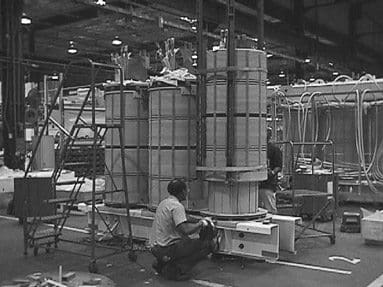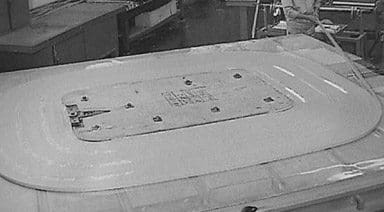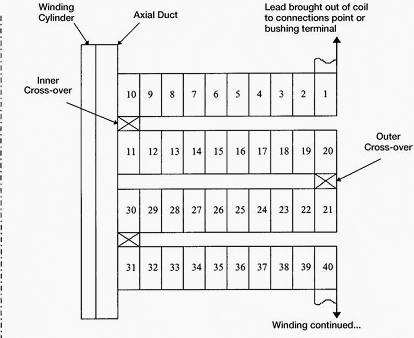
Continued from tech. article: Power Transformer Construction – Core
Construction
The windings consist of the current-carrying conductors wound around the sections of the core, and these must be properly insulated, supported and cooled to withstand operational and test conditions.
The terms winding and coil are used interchangeably in this discussion. Copper and aluminum are the primary materials used as conductors in power-transformer windings.
While aluminum is lighter and generally less expensive than copper, a larger cross section of aluminum conductor must be used to carry a current with similar performance as copper. Copper has higher mechanical strength and is used almost exclusively in all but the smaller size ranges, where aluminum conductors may be perfectly acceptable.
The conductors used in power transformers are typically stranded with a rectangular cross section, although some transformers at the lowest ratings may use sheet or foil conductors. Multiple strands can be wound in parallel and joined together at the ends ofthe winding, in which case it is necessary to transpose the strands at various points throughout the winding to prevent circulating currents around the loop(s) created by joining the strands at the ends.
Individual strands may be subjected to differences in the flux field due to their respective positions within the winding, which create differences in voltages between the strands and drive circulating currents through the conductor loops.

Proper transposition ofthe strands cancels out these voltage differences and eliminates or greatly reduces the circulating currents. A variation ofthis technique,involving many rectangular conductor strands combined into a cable, is called continuously transposed cable (CTC), as shown in Figure 1.
In core-form transformers,the windings are usually arranged concentrically around the core leg, as illustrated in Figure 2, which shows a winding being lowered over another winding already on the core leg of a three-phase transformer.
A schematic of coils arranged in this three-phase application was also shown in Figure 1 (article ‘Power Transformer Construction – Core’).
Shell-form transformers use a similar concentric arrangement or an inter-leaved arrangement, as illustrated in the schematic Figure 3 and the photograph in Figure 7.


With an interleaved arrangement, individual coils are stacked, separated by insulating barriers and cooling ducts. The coils are typically connected with the inside of one coil connected to the inside of an adjacent coil and, similarly, the outside of one coil connected to the outside of an adjacent coil. Sets of coils are assembled into groups, which then form the primary or secondary winding.
When considering concentric windings, it is generally understood that circular windings have inherently higher mechanical strength than rectangular windings, whereas rectangular coils can have lower associated material and labor costs.
Rectangular windings permit a more efficient use of space, but their use is limited to small power transformers and the lower range of medium-power transformers, where the internal forces are not extremely high. As the rating increases, the forces significantly increase, and there is need for added strength in the windings, so circular coils, or shell-form construction are used.
In some special cases, elliptically shaped windings are used.
Figures 4 and 5 show winding arrangements comparing nondirected and directed flow. This concept is sometimes referred to as guided liquid flow.

As mentioned previously, the type of winding depends on the transformer rating as well as the core construction. Several of the more common winding types are discussed below.

Pancake Windings
Several types of windings are commonly referred to as “pancake” windings due to the arrangement of conductors into discs. However, the term most often refers to a coil type that is used almost exclusively in shell-form transformers.
The conductors are wound around a rectangular form, with the widest face of the conductor oriented either horizontally or vertically. Figure 6 illustrates how these coils are typically wound. This type of winding lends itself to the interleaved arrangement previously discussed (Figure 7).


Layer (Barrel) Windings
Layer (barrel) windings are among the simplest of windings in that the insulated conductors are wound directly next to each other around the cylinder and spacers.
Several layers can be wound on top of one another, with the layers separated by solid insulation,ducts,or a combination. Several strands can be wound in parallel ifthe current magnitude so dictates.
Figure 8 shows a layer winding during assembly that will be used as a regulating winding in an LTC transformer.

Helical Windings
Helical windings are also referred to as screw or spiral windings, with each term accurately characterizing the coil’s construction.
A helical winding consists of a few to more than 100 insulated strands wound in parallel continuously along the length of the cylinder, with spacers inserted between adjacent turns or discs and suitable transpositions included to minimize circulating currents between parallel strands.

The manner of construction is such that the coil resembles a corkscrew. Figure 9 shows a helical winding during the winding process. Helical windings are used for the higher-current applications frequently encountered in the lower-voltage classes.
Disc Windings
A disc winding can involve a single strand or several strands of insulated conductors wound in a series of parallel discs of horizontal orientation, with the discs connected at either the inside or outside as a crossover point. Each disc comprises multiple turns wound over other turns, with the crossovers alternating between inside and outside.


Figure 10 outlines the basic concept, and Figure 11 shows typical crossovers during the winding process.
Numerous techniques have been developed to ensure an acceptable voltage distribution along the winding under these conditions.
Reference: Electric Power Transformer Engineering, published May 16, 2012 by CRC Press // chapter Power Transformers authored by H.J. Sim and S.H. Digby (Get this ebook from CRC Press)











Nice informative post…
Sir i want to know about SPACER used in power transformer..what is the main purpose of using it? Whether to provide insulationg between colis or to provide free passage of oil?
22/10/2016
Dear Sir/Madam
I would like to obtain written permission to copy diagrams/pictures from your website for my college assignment.
I am studying for a HNC in Electrical/Electronic Engineering at Bradford College here in the United Kingdom.
I will only use them for my personal educational use and not for any commercial use or not for publishing elsewhere.
I would be very grateful if you could reply as soon as possible. Many thanks.
Yours sincerely
Iwan Medwid
So what are the pros and cons of each type of winding? I have a project where we are replacing two small power transformers at medium voltage. Why would you choose Layer over helical or disc etc? Any info would be great, cheers.
Good post. It’s amazing that one could get this type of information on the internet that electrical engineers can benefit from.
Hello, I wanna create a Power Transformer and I have to design a “3D Double-Pacake Coil” with a tape that has the following dimensions: 4mm x 1mm. The simulation I have to run is a little complicated, but the worst part is to draw this coil. The software I’m using to simulate the project is not good at drawing. Therefore, I wanna design the DP coil at AutoCad and then I’ll export it to the silumate’s software. Could you help me to draw this 3D DP coil? I think you know exactly what it is, right? I’ll wait for your answer. Thank you.